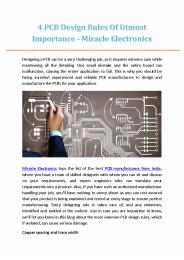Component Placement On A PCB – A Step-By-Step Guide - Miracle Electronics - PowerPoint PPT Presentation
Title:
Component Placement On A PCB – A Step-By-Step Guide - Miracle Electronics
Description:
When manufacturing a PCB assembly from India, it is important to plan up the placement of components thoroughly before placing them, so as to avoid any kinds of possible errors and failures. – PowerPoint PPT presentation
Number of Views:66
Title: Component Placement On A PCB – A Step-By-Step Guide - Miracle Electronics
1
Component Placement On A PCB A Step-By- Step
Guide - Miracle Electronics With the PCB being
such a complex device, it is important that
every tiny component in the circuit design must
fit in well within the physical boundary of the
board, while being correctly in place to make
the right connections, and hence function
properly. There could be a hundred components to
be placed on a single board, which is why you
need an expert manufacturer to build your PCB
assembly, so that any kinds of mistakes and
errors can be avoided. Miracle Electronics is
one such manufacturer who is well-versed at
manufacturing even the most complex PCB assembly
from India, whether it is a µBGA or a surface
mount assembly.
Let us take a look at how such multiple tiny
components are placed onto a board. Although the
PCB layout process is a complicated and
overwhelming procedure, weve broken it down
into multiple steps so as to split up the complex
task into multiple manageable pieces.
2
Step 1 Considering the placement Before
beginning any procedure, it is important to plan
up well. Same is the case with PCB component
placement. You need to understand very well
where and how each component needs to be placed.
You also need to identify the mechanical
constraints on the component location, such as
the location of the connectors, the locations of
heat sinks, the keep-out zones, etc. Also, the
perimeter of the board must be kept free to give
enough space for gripping the PCB during
assembling, and room to score smaller boards to
allow them to be removed from a larger
multi-arrayed panel. A good recommendation is to
keep all components at least 0.050 from the PCB
edge. Further, taller and more fragile
components should be kept at least 0.125 from
the edge to prevent damage and allow room for
tooling access when the board is routed or
scored from the panel. Another important aspect
to consider is to simplify routing and grounding
in a way that the noise between power
components, high-speed digital components, and
analog components is minimized. Also, the power
supplies and associated components should be
grouped together, as far as possible from
noise-sensitive section of the circuit. Step 2
Locating active components The next step is to
located the active components on the board, such
as the BGAs, quad packs, and other large high pin
count components. It is the room needed to fan
out the pin counts that drives the locations of
all the components around them. Thus, the active
component ICs need to be aligned with the 1 pin
or A1 pin in the same orientation, so that the
inspection and debugging of the initial
prototypes becomes less frustrating.
3
Step 3 Locating passive components Once the
active components are in place, the next step is
to locate the passive components on the board.
The bypass or decoupling capacitors on the power
pins should be located as close to the IC as
practical to minimize the parasitic inductance.
The lowest value capacitor should be placed
closest to the power pin. The bypass capacitors
should be located on the opposite side, directly
under the power pin. And, each power pin should
have its own bypass capacitor. The polarized
components like electrolytic capacitors and
diodes should be arranged such that they all face
in one direction. Lastly, the inductors should
be placed apart, because placing them too close
together can cause inductive coupling, changing
their value, thanks to their property of
generating magnetic fields. For double-sided
boards When youre thinking of designing
double-sided PCBs (https//www.miracle.net.in/blo
g/single-sided- double-sided-pcbs-one-choose/), i
t is recommended to place the lighter and more
heat resistant components on the bottom side.
This is because double-sided PCBs have to pass
through the reflow oven twice. Moreover, the
larger components at the bottom need to be glued
to keep them from falling off. The smaller
passive components cannot be glued, but the
surface tension of the solder holds them in
place during the second pass through the
oven. These are some very basic guidelines to
help with the right component placement on a PCB
assembly from India. But, for more complex and
distinctive kinds of PCBs, you must always have
an expert PCB manufacturer partnered to ensure
that the
4
product is appropriate for the application, and th
oroughly reliable. For more Information
https//www.miracle.net.in/































